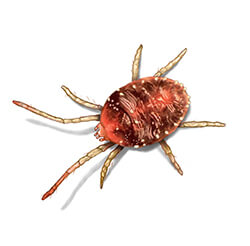Identification
- Colour Tan, grey, brown, reddish-brown, bright red, blue, or green
- Size From 0.1 mm to 1 mm long
- Description Have bulbous, round, or pill-shaped bodies, with eight jointed legs

How to identify Mites
Similar in appearance to ticks but much smaller, mites have bulbous, round, or pill-shaped bodies. Classified as arachnids, mites have eight jointed legs. Their size varies by species, but most mites are usually invisible to the naked eye. The largest mites measure about 6 mm long, while the smallest are about 0.1 mm. The colour of mites varies greatly as well; most mites appear tan, brown, or reddish-brown, but some species are bright red, blue, or green in colour.
Signs of an infestation
Canada is home to several thousand species of mites, including clover mites, house dust mites, bird mites, itch mites, and scabies mites, cheese mites, grain mites, flour mites, and mould mites. Most are usually invisible to the naked eye.
Mites live in nearly every habitat, including deep soil and aquatic environments. As parasites of birds, mammals, and insects, mites may spread wherever these host animals travel. Mites either live in the host’s nest or on the host itself.
Some species such as scabies and chigger mites may bury themselves under human skin. Mites that commonly affect humans often live in carpets, furniture, and mattresses.
Common household mites, like dust mites, feed on flakes of dead skin from humans and pets, but others mites do bite animals and in some cases, humans, to suck their blood.
How to prevent Mites from invading
Mow lawn and remove weeds regularly, Keep leaf litter away from the house, Keep pets clean and healthy, Clean the house regularly, Dust surfaces and vacuum carpets, Wash bed linens in hot water, Keep humidity levels low, Use a dust-mite or mite proof mattress encasement
Habitat, Diet, and Life Cycle
Habitat
Mites are ubiquitous and live in nearly every habitat, including deep soil and aquatic environments. As parasites of birds, mammals, and flying insects, mites may spread wherever host animals travel. These arachnids live either in the host’s environment, such as a bird’s nest, or on the host itself. Some species such as scabies and chigger mites can bury themselves under human skin and tissue. Mites that commonly affect humans often live in carpets, furniture, and mattresses.
Diet
Mites thrive by forming parasitic relationships with other organisms. Specific diets vary by species. Mites that are troublesome to humans feed on blood for sustenance. Most biting mites actually prefer to feed on other animals and resort to biting humans when alternative options are scarce. Common household mites, like dust mites, feed on flakes of dead skin from humans and pets.
Life Cycle
The mite lifecycle consists of four stages: egg, larva, nymph, and adult. Eggs hatch into six-legged larvae, which molt several times before entering the eight-legged nymphal stage. As nymphs, mites molt an additional one to three times before maturing into full grown eight-legged adults. Development from an egg to an adult usually takes several weeks; however, under ideal conditions development time can shorten to just a few days. After reaching adulthood, mites may live for several months.
Commonly Asked Questions
How worried should I be about mites?
While some mite bites can go unnoticed, others can be painful. Nearly all result in itchy red marks or rashes. Intense itching may occur, and scratching may lead to infection. Symptoms usually develop within a day and may last as long as a week.
Scabies mites can cause persistent, intensely itchy rashes, because the pests burrow into the skin to breed and then emerge to feed on flesh which can result in a severe medical condition.
The carcasses of dust mites, which live in carpets and furniture, can cause allergic reactions if inhaled, resulting in stuffy noses, watery eyes, and sneezing. Meanwhile, spider and eriophyid mites can damage crops.
It’s difficult to see mites, so you may not be aware of an infestation until it’s too late.
Types of Mites
100% Satisfaction or Money Back Guarantee
Resolving your pest problem is our #1 priority. If re-treatment is required, we'll provide immediate services at no extra cost. If your expectations are not met, we guarantee a full refund of your service payment.
Remove pests from your home, and stop them from coming back
We work hard to listen, understand and assess your unique situation. Request a free, no-obligation estimate today for a customized pest program that fits your needs.
Request a Free Home EstimateRequest a Free Business Consultation

